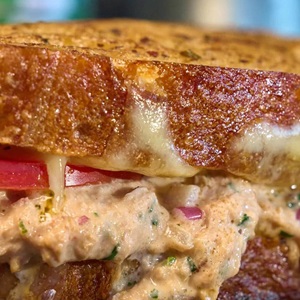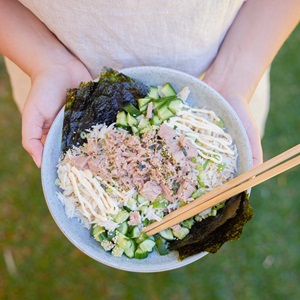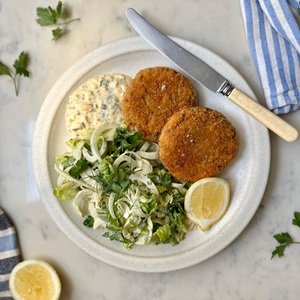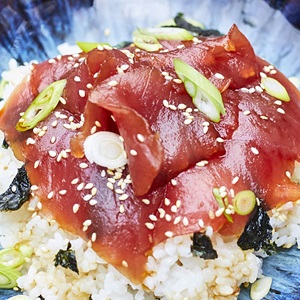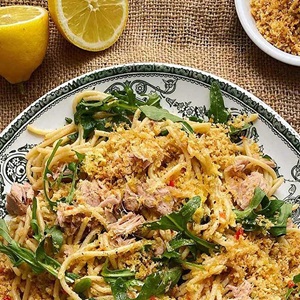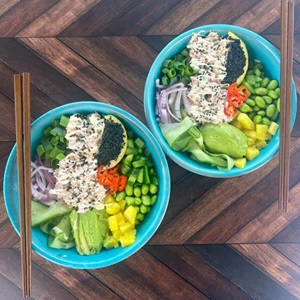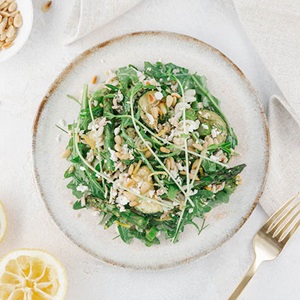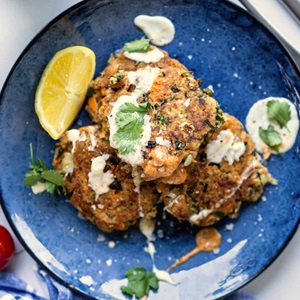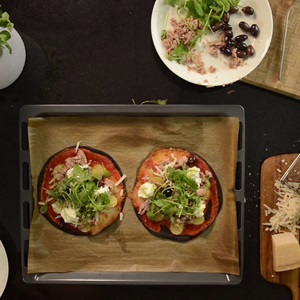Find out more about tuna, a nomadic species found throughout the world’s ocean. Find out which tuna is sustainable and where to buy sustainable tuna.
What is tuna?
Tuna is a meaty fish. It belongs to a subgroup of the mackerel family, consisting of 8 species varying in colour and size. Tuna is a nomadic species and can be found throughout the world’s ocean.
Tuna can be eaten fresh or canned. Tuna loin is commonly eaten raw or seared and lightly seasoned, while canned tuna is precooked for a long time and often prepared heavily dressed.
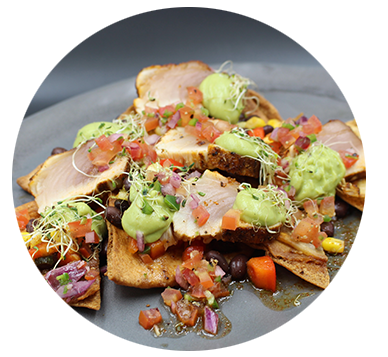
Tuna facts
- There are five main types of tuna: Skipjack, Albacore, Yellowfin, Bluefin, Bigeye
- Skipjack tuna is the smallest and most abundant of the major commercial tuna species, growing up to around a metre in length
- Yellowfin tuna can grow to more than two metres and weigh close to 200 kilograms
- Almost half of the global tuna catch is caught in the Western Central Pacific Ocean
- Tuna is an extremely large fish. The biggest tuna catch to date was in Aulds Cove off Nova Scotia by Ken Fraser in 1979. It was an Atlantic bluefin, at the record weight and length of 679kg (1,497lb) and 3.7m (12ft). That’s almost as heavy as a truck!
- All the tuna we eat is caught wild from the ocean. Tuna are carnivores at the top of the food chain, so it is vital to look after the whole ocean ecosystem. For a tuna to gain 1 kilo requires roughly 10 kgs of mid-size fish, 100 kilos of small fish, 1000 kilos of small plant-eaters (herbivores such as zooplankton) and 10000 kilograms of phytoplankton.
- Tuna is a global commodity, accounting for more than 8% of the global seafood trade. By 2027, the canned tuna market could be valued at as much as $US 11.89 bn.
- Tropical skipjack can reproduce from about 2 years old and an adult female can spawn as many as 2million eggs daily, and any time of year. Once fertilised, the tiny eggs hatch within a day, floating on the ocean currents as zooplankton. Tuna in cooler waters have a longer lifecycle, for example, albacore tuna in the Indian Ocean, is usually 5-6 years old before reproducing, spawning every 2.2 days from November to January with females releasing as many as 2.6 million eggs.
Main types of tuna
Skipjack
Actually, a related species to tuna grow to a max weight of 35 kg and is commonly purchased as canned tuna.
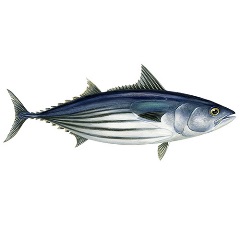
Albacore
With large pectoral fins, this grows up to 60 kg and is found fresh, in cans and preserved in jars.
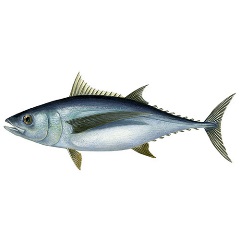
Yellowfin
As the name suggests they have bright yellow fins and finlets. You'll find yellowfin fresh as steaks and in cans.

Bluefin
These giant fish grow to be up to 700 kg! Despite this, they're as fast as a car. Bluefin tuna is most commonly found in sashimi and sushi.
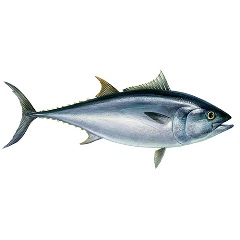
Bigeye
These tuna have big eyes and grow to be up to 210 kg. They swim at depths of 500 m and so have a protective layer of fat that makes them the 'white beef' of sashimi.
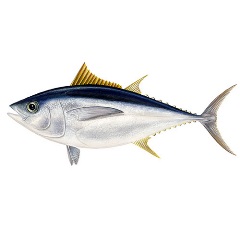
Is tuna sustainable?
There is no such thing as a sustainable species—only sustainable fish populations, managed responsibly through science-based rules and oversight.
According to the MSC's latest Tuna Yearbook, Tuna fisheries vary greatly in their environmental impact. Some are linked to significant bycatch of species like seabirds, sharks and marine mammals, depending on how and where the fishing takes place. But growing momentum for sustainable fishing practices is changing the industry.
According to the MSC Global Tuna Yearbook 2025:
Global wild tuna catch reached 5.9 million tonnes in 2022.
More than 57% of global wild tuna catch is now either MSC certified or under assessment, showing major progress in responsible sourcing.
Over 300,000 tonnes of MSC labelled tuna were sold in 2024/25—a 24% increase from the previous year.
Tuna with the MSC blue label is now available in 63 countries.
Stock status varies by species and region:
Skipjack tuna stocks are mostly healthy, but rely on continued effective management.
Yellowfin tuna in the Indian Ocean remains overfished, despite some management improvements.
Bigeye tuna is overfished in the Atlantic Ocean.
Pacific bluefin tuna populations, both north and south, remain overfished but are showing signs of rebuilding.
The UN and ISSF have tracked a reduction in the number of major tuna stocks experiencing overfishing—from 13 in 2014 to 5 in 2019—indicating positive trends in some regions.
The MSC programme continues to support better fisheries management, more selective fishing methods, and supply chain transparency. The blue MSC label helps consumers identify tuna that is independently verified as sustainable and traceable from ocean to plate.
Each World Tuna Day, the MSC campaigns to accelerate action for sustainable tuna.
Where can I buy sustainable tuna in Australia and New Zealand?

You'll find sustainable tuna with the MSC blue fish tick meaning it comes from a fishery that has been independently assessed to the MSC Fisheries Standard as a well-managed and sustainable fishery.
You'll find a wide range of MSC certified wild Alaskan salmon with the blue fish tick in all major supermarkets in Australia and New Zealand.
- Canned skipjack tuna: Coles, Coles Simply, Coles Pacific, East Coast Tuna Co, John West, Pams, Safcol, Terra Madre, The Stock Merchant
- Canned albacore tuna: East Coast Tuna Co.
- Canned yellowfin tuna: Wild Tides, Terra Madre, John West
- Tuna slices: The Stock Merchant
- Preserved albacore tuna: Walker's Tuna
- Petfood: Dine cat food
- Food to go: John West tuna lunch kits, Coles
- Frozen tuna portions: I&J
Find out more about where to buy sustainable seafood.
Learn more about tuna fishing
Worldwide there are 23 stocks of the major commercial tuna species: 5 skipjack, 4 yellowfin, 4 bluefin, 6 albacore, and 4 bigeye stocks. Some of these tuna stocks have healthy numbers and are being managed well, others are not.
There are different ways of catching tuna. The methods and gear used in tuna fishing could depend on:
- Which tuna species are being fished
- Where the tuna lives
- The size of the tuna
Common gear types used by MSC certified tuna fisheries include pole and line, purse seine nets and longlines.
Any of these gear types can be used sustainably, depending on their use, the amount of tuna being caught and how their gear affects the wider ecosystem.
There is also discussion around the sustainability of tuna caught using Fish Aggregating Devices (FADs), which if managed well can also be considered sustainable.
Tuna Australia members operating in the Eastern Tuna and Billfish Fishery now hold MSC certification for albacore, yellowfin, bigeye and swordfish.
Sustainable tuna fishing stories
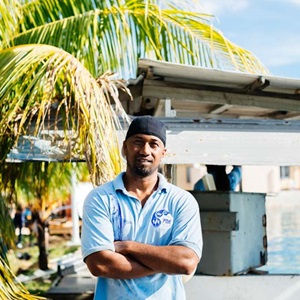
PNA tuna: Small islands, big opportunities
The Parties to the Nauru Agreement (PNA) manage a vast Pacific tuna fishery, employing sustainable practices like free-school purse seining and 100% observer coverage, earning MSC certification.
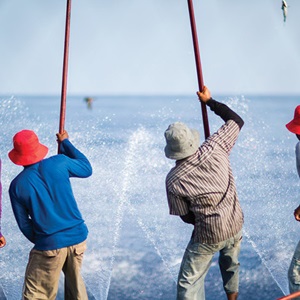
Maldives skipjack tuna: a sustainability success story
The Maldives' pole-and-line skipjack tuna fishery, certified by MSC in 2012, employs traditional, low-impact methods, supporting 30,000+ livelihoods.

Owasebussan: Japan’s all-in-one sustainable tuna company
Owasebussan uses MSC-certified longline tuna fishing with bycatch reduction, revitalising local communities through sustainable, fresh seafood.
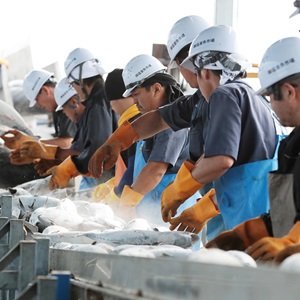
Meiho: tuna fishing after the tsunami
After Japan’s 2011 tsunami, Meiho Fishery rebuilt using MSC-certified pole-and-line tuna fishing, reviving the local economy with sustainable practices.
New Zealand Albacore Tuna
Dolphin-friendly tuna explained
Most tuna species have nothing to do with dolphins. Yellowfin tuna are associated with dolphins in parts of the Pacific Ocean, where the species often swim close together.
In these places, dolphins swim near the water surface, with yellowfin tuna up to 150 metres below. The reasons for this flocking behaviour are uncertain and are only observed in older yellowfin tuna.
Historically, fishers in the Eastern Tropical Pacific near Central America have used the presence of dolphins to find yellowfin tuna.
Tuna in the Eastern Tropical Pacific is usually caught with purse seine nets, which surround a school of fish before being pulled together. Because dolphins swim above tuna, accidental catch (bycatch) of dolphins has been high in the region.
In 1989, the dolphin bycatch for Mexican purse seine tuna fisheries was 132,000 animals. A new strategy was needed and more selective fishing methods were introduced. Between 1985 and 1997 dolphin mortalities dropped by 99%.
Since 2017, the Northeastern Tropical Pacific Purse Seine yellowfin and skipjack tuna fishery have been MSC certified.
Dolphin safe, or dolphin-friendly labels mean that tuna has come from boats with no interaction with dolphins. These labels don’t provide any reassurance about the wider impacts of tuna fishing.
Whereas the MSC blue fish tick label means that the tuna was caught with consideration for the wider marine environment, including impacts on species such as dolphins.
Most popular sustainable tuna recipes
As well as our delicious sustainable tuna recipes, we've prepared a guide to cooking with sustainable tuna. Our guide to cooking with sustainable tuna guide will help you go that extra mile and know how to get the best out of your yellowfin, your albacore or a $1 tin of skipjack.Explore more sustainable fish to eat
Find more sustainable seafood species that are MSC certified in Australia and New Zealand.
Explore the sustainable seafood guide.
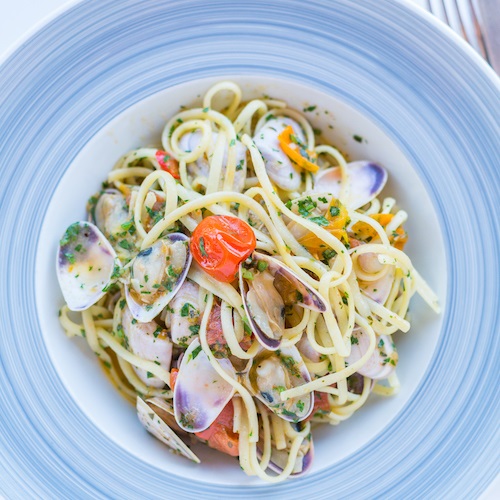
Sustainable seafood recipes
Chefs and seafood lovers from around the world share quick and tasty ways of cooking MSC certified seafood.
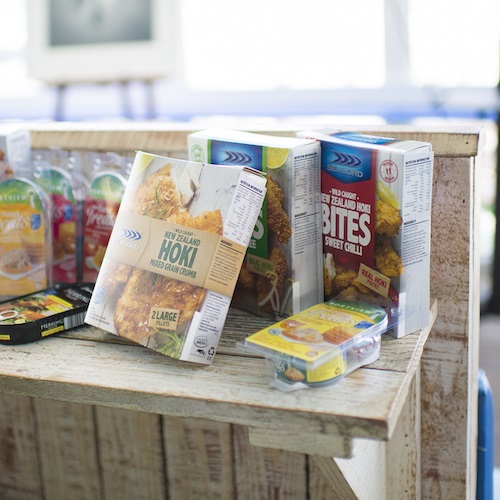
10 reasons to choose the blue fish tick
Choose seafood which helps to protect oceans, livelihoods and fish for the future.

Buy sustainable seafood
Where to find the blue fish tick at supermarkets, fish shops and restaurants.


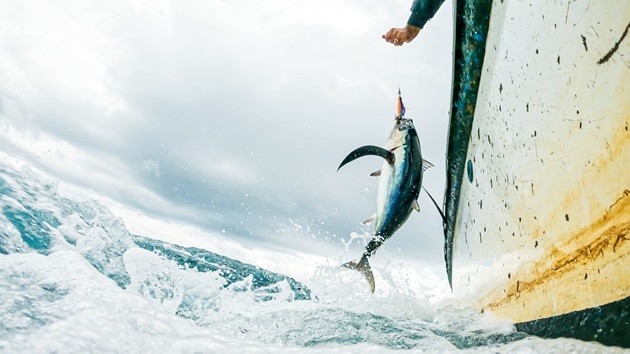

.tmb-thumb300.jpg?Culture=en-AU&sfvrsn=2e161392_1)
